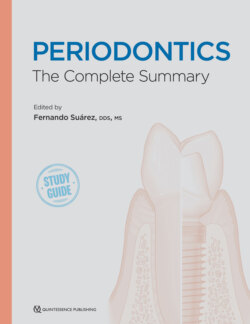Читать книгу Periodontics - Fernando Suarez - Страница 101
На сайте Литреса книга снята с продажи.
PALATORADICULAR GROOVES
ОглавлениеThe palatal groove is a developmental, anomalous groove usually found on the palatal aspect of maxillary central and lateral incisors. It is also known as palatogingival groove or palatoradicular groove.1 These structures are considered a funnel-like anomaly predisposing to the accumulation of biofilm and calculus formation.125–132 The prevalence of this condition ranges from 1.9% to 18%, affecting primarily maxillary lateral incisors and central incisors with a possible predilection for individuals of Asian descent (Table 5-10).70,127,128,131,133–135
TABLE 5-10 Prevalence of palatoradicular grooves
| Authors | Population | Affected teeth | Prevalence |
| Everett and Kramer133 | American | Lateral incisors | 1.9% |
| Gher and Vernino70 | American | Lateral incisors | 3% |
| Withers131 | American | Lateral and central incisors | Overall: 2.33%Bilateral: 0.75%Lateral incisors: 4.4%Central incisors: 0.28% |
| Kogon127 | Canadian | Lateral and central incisors | 4.6% |
| Bačić et al128 | Croatian | Lateral and central incisors | 1.01% |
| Hou and Tsai134 | Taiwanese | Lateral and central incisors | 18.06% |
| Albaricci et al135 | Brazilian | Lateral and central incisors | Overall: 9.3%Lateral incisors: 11.1%Central incisors: 7% |
Embryologically, these anomalies arise as a mild form of invagination from the folding of the enamel epithelium and are closely related to dens in dente.133 As a result, a clinically detectable hollow groove can be observed proceeding apically for a variable distance along the length of the root. Hou and Tsai noted an increased predilection of these grooves for midpalatal areas (42.5%) when compared with mesial (27.4%) and distal (30.1%) surfaces.134 Moreover, it has been reported that 58% of the grooves extended more than 5 mm from the CEJ,127 whereas 8.6% can reach the root apex.135 Radiographically, these might be detected as radiolucent, parapulpal lines representing a radicular extension of the palatal groove.126,130
Localized forms of periodontitis have also been associated with the presence of palatoradicular grooves.128,130–132 Teeth with palatoradicular grooves revealed worse periodontal health as evidenced by higher gingival index, plaque index, and periodontal disease index scores when compared to teeth without grooves.131 Similarly, Bačić et al reported significantly greater probing depths (mean: 8.8 mm) at sites with palatoradicular grooves among periodontal patients.128 Hou and Tsai also noted deeper pocket depths when palatoradicular grooves were present.134
